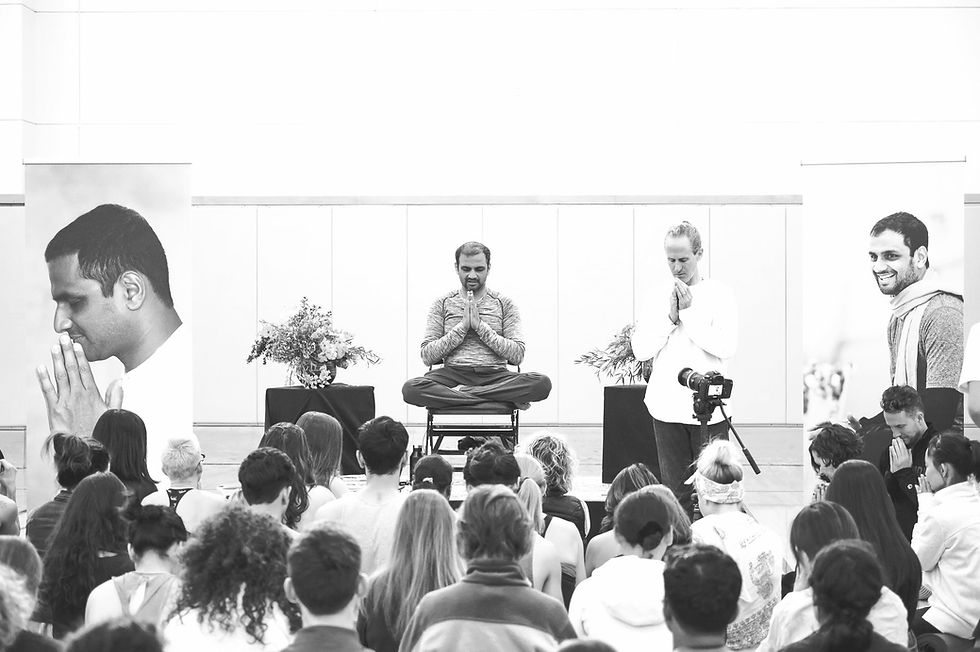The Meditative Magic of Tristhāna in Ashtanga Yoga
- Andrew Hillam
- Jan 31, 2017
- 3 min read

The secret to heightened clarity and peacefulness lies in how well you implement tristhāna. Done correctly and consistently, it can help you achieve a more meditative state in your daily life and practice.
When asked about the Ashtanga method that he taught, teacher K. Pattabhi Jois would often say, ‘This is not my yoga, this is the Ashtanga Yoga of Patanjali.’ Patanjali was a great Indian philosopher best known for The Yoga Sutras, the most respected text on classical yoga written several millenniums ago. Within this work is outlined the method of Ashtanga Yoga, which in English means the “eight limbs of yoga.” The last three of these limbs are successively deeper states of concentration, including the state of meditation. It is important to develop these limbs in your daily practice and by focusing on tristhāna you can achieve a deeper level of concentration and awareness on the mat, which carries through to your daily life.
Tristhāna is a Sanskrit term that means “three dwelling places.” The term describes the three areas you should maintain attention during your yoga practice. Those three places of attention include
1) the yoga posture,
2) the breathing system, and
3) the looking or gazing place.
Each element of tristhāna has a technique that you should follow, however, there is a more subtle aspect or quality of each technique that we can explore. It is these subtle aspects that bring you to a deeper experience of concentration within your practice. The following descriptions explore the three techniques of tristhāna and the qualities that you should bring to them. Like in all yoga practices, each element of tristhāna should be learned and practiced under the guidance of a qualified teacher.
The Yoga Posture
During your practice, you should focus on the correct technique for each posture, paying attention to its form as well as how you safely enter and exit the posture. At a more subtle level, The Yoga Sutras state that you should find the dual qualities of steadiness and comfort in any given posture. They elaborate that you should cultivate the appropriate amount of ‘looseness’ and effort so that there is no unnecessary tension in the posture.
Mastering of the posture can come about by meditating on the form of ananta, which means endlessness, giving a more subtle aspect to those qualities. Ananta is also a reference to a great snake—a famed Indian mythical creature—that lies coiled in the cosmic ocean supporting the enormous weight of the universe. Even while supporting this heavy burden, Ananta preserves the qualities of comfort, peacefulness and serenity, which requires great strength and stability.
The Breathing System
The breathing technique used in Ashtanga Yoga calls for deep and even thoraco-diaphramagtic inhales and exhales of the same duration. The breath should be long and smooth throughout the entire practice. There are many benefits to this method, including the efficient uptake of oxygen and removal of carbon dioxide and other waste products in the lungs. Correct breathing techniques will also improve your postural alignment and support stability and relaxation within the posture.
When you breath properly, the calming effect on the nervous system is profound. This, in turn, immediately influences the mind, allowing you to maintain your attention more easily and with far greater awareness. Practicing this method of breathing strengthens and purifies the lungs along with all aspects of the breathing system. As you practice, and gradually bring the breathe under your control, you are also able to more easily bring the mind under control.
The Looking Place
Also called dṛṣṭi, this third place of attention relates to how you use your eyes. In Ashtanga Yoga, every posture and movement has a prescribed ‘dwelling place’ where you should fix your gaze. There are nine different gazing places and each posture and movement in Ashtanga Yoga uses one of these:
1) ūrdhva – up into space 2) brūmadhya – between the eyebrows 3) nāsāgra – the tip of the nose 4) pārśva – right side 5) parśva – left side 6) nābhi – the navel 7) hastāgra – tip of the hand 8) aṅguṣṭhāgra – thumbs 9) pādāgra – tip of the big toe
The technique of gazing requires keeping your eyes completely still so that they do not wander from their place of attention. The quality of the action should be one of softness as well as stillness and both qualities will be reflected in your mind. When you concentrate on this one sense, sight, you simultaneously reduce the reactivity of your four other senses. Distractions, like sounds and smells, are dulled. The technique of gazing is very powerful and this final place of attention is key to finding a meditative aspect to practice.
By Andrew Hillam Originally published on sonima.com on January 25, 2017





































Comments